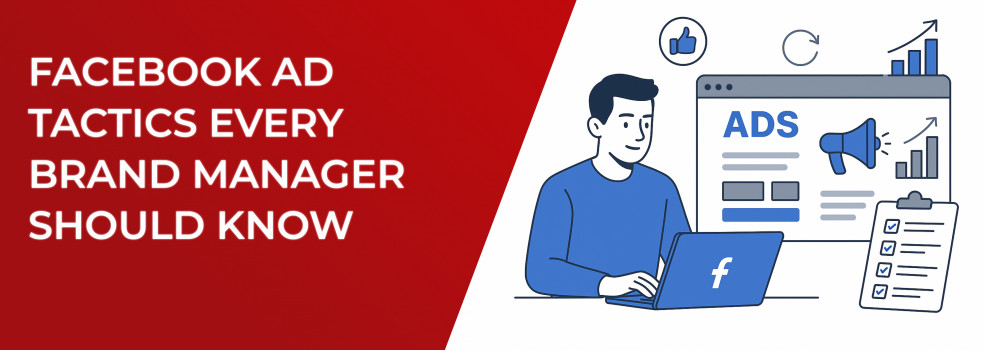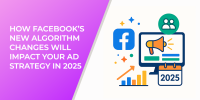Facebook advertising is no longer just a nice-to-have. For brand managers it is a must-have tool that helps you stay competitive, reach the right audience, and spark measurable growth. Running ads, however, is not the same as running them well. To succeed you need to understand how the platform works, what drives performance, and how to optimize campaigns continuously.
Why should Facebook ads be a priority?
-
The platform is one of the most data-rich advertising ecosystems available
-
Deep audience targeting and scalable campaign tools are built in
-
Performance is measurable across every stage of the marketing funnel
Together, these advantages make Facebook a cornerstone of modern media plans.
Still, with so many features and options, even experienced marketers can overlook critical tactics. Mastering the strategies below will help you:
-
Maximize return on ad spend (ROAS)
-
Avoid wasted budget on under-performing campaigns
-
Stay ahead of algorithm shifts and platform updates
By keeping these goals in mind, you’ll approach each tactic with purpose and perspective.
1. Know Your Numbers: Ad Impressions and Benchmarks
Visibility matters, but impressions alone do not equal success. Track ad impressions Facebook delivers, then compare results against the industry benchmark CTR. According to current studies, the industry average CTR for display ads sits around 0.90 – 1.60 percent. If your campaign falls below that, consider tightening audience segments or refreshing creative.
A good Facebook ad CTR means different things in different niches, so log results weekly and chart your own benchmarks. Use these figures to spot drops early and course-correct before spend balloons.
Quick checklist
-
Monitor reach, impressions, and frequency inside FB Ads Reporting
-
Benchmark CTR and cost per thousand (CPM) against industry averages
-
Flag any audience segment with high spend but low clicks for review
Following this checklist keeps your visibility metrics disciplined and actionable.
2. Get Out of the Learning Phase Fast
Every new ad set enters Facebook’s Meta learning phase, a period when the algorithm looks for enough conversion signals to optimize delivery. If you see the “learning limited Facebook ads” warning you have not reached at least 50 optimization events per week.
Watch for the ‘Learning Limited’ tag, it signals your campaign needs more optimization events.
Advantage Campaign Budget helps here. By allowing Facebook to move spend between ad sets automatically, you are more likely to hit event volume quickly and escape the learning bottleneck.
Stuck ads can also trigger the dreaded “Ad Set May Get Zero” warning — learn why it appears and how to fix it before your budget stalls.
Tactics to accelerate learning
-
Combine small audiences rather than running micro-segments
-
Set realistic daily budgets so each ad set can generate events
-
Pause creative tests that siphon spend without conversions
These actions shorten the learning curve and unlock steadier performance sooner.
If you need detailed step-by-step tactics, check how to finish the Facebook learning phase quickly.
3. Pixel Power: Tracking, Retargeting, and Measurement
Wondering what is Pixel on Facebook? The Facebook or Meta pixel is a small snippet of JavaScript that tracks site actions and feeds conversion data back to Ads Manager. Correct pixel setup unlocks:
-
Retargeting pixels that let you serve ads to recent visitors
-
Lookalike audiences based on high-value site actions
-
Accurate attribution for purchase and lead events
Leveraging these capabilities puts your data to work and sharpens every subsequent campaign. If you have not yet done so, create pixel on Facebook by following Ads Manager prompts, then validate implementation with the Test Events tool.
4. Budget Smarts: Campaign Budget Optimization
Manual ad-set budgets can lead to uneven delivery and wasted spend. Switch to campaign budget optimization to let Facebook push budget toward the highest-performing ad sets in real time. Inside Ads Manager you will see the option labeled Advantage Campaign Budget.
Picking the wrong objective at campaign setup can cripple delivery, so brush up on Meta ad campaign objectives and how to choose the right one.
When cost control is critical, layer CBO with FB pay per click bidding. Paying only for clicks keeps tests affordable while you validate new creative.
Key points to remember
-
Set a sensible minimum and maximum bid if you need tighter control
-
Review spend distribution daily in FB PPC reports
-
Split campaigns by objective so budgets remain focused on single goals
Treat these guidelines as guardrails, ensuring CBO runs efficiently without surprises.
5. Creative and Targeting: Optimize, Test, Iterate
Even the best budgets cannot rescue stale creative. Schedule weekly reviews inside Ads Manager or train your team with a structured Meta ads training program. Whenever performance dips, refresh thumbnails, change copy angles, and rotate placements.
Do not stop at interest targeting. Use lookalike audiences and behavior-based retargeting built from your pixel data. For quick edits and publishing, show junior staff how to find Ads Manager on Facebook then create saved reports to keep everyone on the same page.
For a targeting refresher, revisit Facebook Ad Targeting 101 and make sure your audiences are laser-focused before scaling.
Pro tips
-
Run no more than three active creatives per ad set to avoid dilution
-
Test multiple formats: single image, carousel, and short-form video
-
Lean on Facebook ad optimization rules to automate pauses on high-cost ads
Implementing these creative best-practices prevents fatigue and sustains momentum.
Drop in CTR and rising costs? You may be seeing the early signs of ad fatigue.
Rotating creative is also your best defense against fatigue — here’s how to spot ad fatigue early and fix it fast.
6. Analyze and Adapt
Great campaigns are never set-and-forget. Dive into FB ads reporting or export data to your preferred dashboard every week. Focus on:
-
Cost per result versus ROAS
If clicks are high but conversions are lagging, see why Facebook ads stop converting and how to turn them around. -
Breakdown by placement, device, and age
-
Overlap between prospecting and retargeting lists
Consistently acting on these insights refines your Meta campaign structure and compounds gains over time.
Conclusion
Facebook advertising rewards brand managers who track the right metrics, respect the algorithm, and keep creative fresh. By focusing on impression quality, rapid learning, pixel-driven targeting, and smart budget controls, you can elevate Facebook ad performance without ballooning spend.
LeadEnforce can help you go even further. Our advanced audience builder pinpoints the people most likely to buy, ensuring your ads reach high-intent users from day one. Ready to see what precise targeting can do for your next Meta ads campaign? Get in touch and let’s boost your results together.

